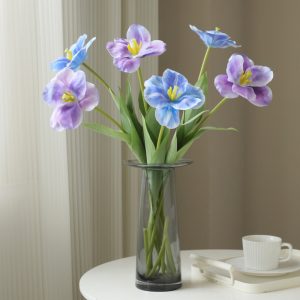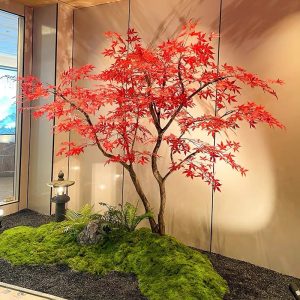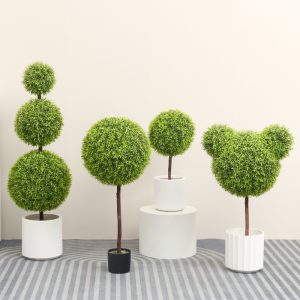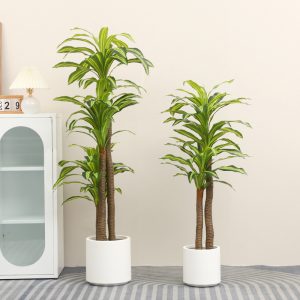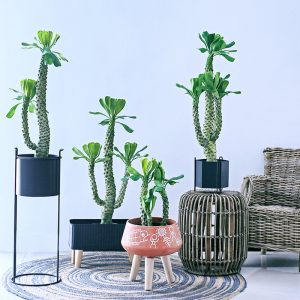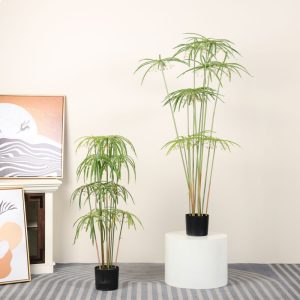Introduction: A New Era of Green Commercial Design
With ESG and sustainability concepts becoming deeply integrated into corporate strategies, green space design is no longer just a “nice-to-have” — it has become a necessity for both brand image and regulatory compliance. While live plants bring a natural atmosphere, they often come with high maintenance costs in large-scale spaces such as hotels, shopping malls, and airport terminals: watering, pruning, pest control, and strict dependence on light and climate conditions.
As one shopping mall operator remarked: “Our annual plant maintenance budget is enough to cover a full renovation.” Against this backdrop, artificial plants are emerging as the green solution for commercial spaces — creating a natural look while avoiding the burden of ongoing upkeep.
Global Market Trends
Growth Data and Forecasts
According to Grand View Research, the global artificial plants market exceeded USD 15 billion in 2024, and is projected to expand at a 6.5% CAGR through 2030. In the wholesale sector, B2B demand is surging. From hotel group bulk procurement to annual décor updates in retail complexes, artificial plants are increasingly becoming a fixed budget item.
Key Application Scenarios
- Hotel Lobbies & Ballrooms: Five-star hotels often install large artificial green walls in lobbies to ensure a consistent, year-round visual impact.
- Shopping Malls & Office Buildings: Public spaces demand evergreen displays, and artificial plants maintain a cleaner, more uniform look than live plants.
- Restaurants & Airports: Beyond decoration, artificial plants help define areas and enhance comfort for visitors.
Regional Differences
- Europe & North America: Designers emphasize eco-friendly materials and visual authenticity, aiming for seamless integration with the overall interior style.
- Middle East: Hotels in Dubai often highlight UV resistance and heat durability to withstand extreme climates.
- Asia: Malls and office towers prioritize cost-effectiveness and customization, with high demand for seasonal theme décor.
Core Needs in Commercial Spaces
Cost and Maintenance Benefits
The biggest advantage of artificial plants is zero maintenance. No watering, no pruning, no worries about insufficient sunlight. For malls, this translates into annual savings of hundreds of thousands, even millions, in maintenance budgets (JLL Facility Management Benchmark Report).
Design Flexibility
Artificial plants provide greater creative freedom for designers. From grand lobby green walls to small table-top arrangements in restaurants, or seasonal displays in shopping malls — setups can be completed quickly without climate limitations.
Environmental and ESG Value
More manufacturers are adopting eco-friendly PE and silk materials, with some offering recyclable or certified sustainable options (Sustainable Furnishings Council Report). For companies required to submit ESG reports, artificial plants serve as a dual advantage for compliance and brand image.

Artificial Flower Arrangements
Wholesale Procurement Trends and Recommendations
Upgraded Quality and Materials
While early plastic plants faded easily, today’s mainstream suppliers use eco-friendly PE, silk, and UV-resistant materials, extending lifespan and ensuring vivid color even in outdoor settings.
Shift in Procurement Channels
In the past, businesses relied heavily on offline trade shows such as Guangzhou or Frankfurt. Today, more buyers are turning to B2B platforms and direct orders from independent websites. This reduces intermediaries and ensures more competitive pricing.
Supply Chain and Brand Selection Advice
- Direct Factory Supply: Avoids multiple layers of agents, offering more control over pricing and delivery time.
- OEM/ODM Customization: Ideal for hotel groups and design firms with branding needs.
- MOQ (Minimum Order Quantity): Requirements vary widely by supplier; clarity before purchase is essential.
Future Outlook
The wholesale artificial plant market is set to follow three major directions:
- Eco-Friendly, Biodegradable Materials: With policy support, biodegradable options will become standard (European Commission: Biodegradable Plastics Directive).
- Smart Integration: Artificial plants will increasingly merge with smart lighting and digital displays to create immersive spaces.
- Green Procurement Policies: More multinational corporations will include artificial plants as part of their ESG-compliant supply chains (United Nations Global Compact – Sustainable Supply Chains).
Artificial plants are no longer just “substitutes” — they have become a key tool in the green upgrade of commercial spaces. For hotels, malls, and office buildings, they not only reduce long-term costs but also strengthen competitiveness in sustainability.
The wholesale market in 2025 is set for rapid growth. Those who secure high-quality supply chains early will gain a decisive edge in the next wave of green commercial competition.








